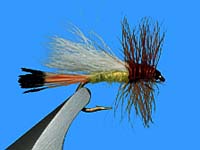
MATERIALS
- Hook: Tiemco 100; Mustad 94840; Daiichi
1180; #12 - 20
- Thread: 6/0 or 8/0, color to match body
- Tail: Golden Pheasant tippets
- Body: Superfine dubbing: chartreuse, pink,
lime, orange, black; also, there is the Royal Trude, with peacock and red floss or mylar.
- Wing: Calf body hair, white
- Hackle: Brown or ginger high quality dry
fly hackle.
|
The Trude
Andy Burk, a well known tyer who now works for
the Reno Fly Shop, recently published an article on the Trude patterns. I have always kept
some of these in my fly boxes - sometimes the trout just want a down-wing, low-profile
pattern, and the Trude fits the bill perfectly. According to Andy’s research, the
Trude originated in 1901 on the A. S. Trude ranch in Big Springs, Idaho. The first Trude
was presented to the ranch owner as a gag, having been tied on a huge 3/0 or 4/0 hook. Mr.
Trude had the idea of turning the basic, simple pattern into a fishable streamer fly--
thus was born a tried and true producer. Dan Bailey took it from there and converted it
into a dry fly. The rest is history. The Trude can be tied in many colors and sizes, but
its beauty lies in its simplicity. Recently, a member asked that the patterns for the
contest be confined to those using simple, easily available materials. While we won’t
always do that since there are others who hold different opinions, the Trude is the
essence of simplicity of both design and composition. Oh, and by the way....it catches
fish.
|
INSTRUCTIONS
After debarbing the hook, cover shank with
thread and advance thread to a point just above rear of barb. This will be the tail tie-in
point.
At the tail tie-in point, tie in 6-8 fibers
of Golden Pheasant tippet. The length of the tail is 3/4 of the shank length.
Dub a slim body to a point about 1/3 shank
length behind eye.
Take a small bunch of calf hair and clean
out the under fur. This will become the wing, which should extend to the tip of the tail.
It should be tied in where the front of the body ends. Hints: trim the wing to length
before tying it in; apply flexament to butts before tying it in also--these measures will
make it easier to control the butts and keep the wing on top. It should be tied in so that
it is "down-wing" style, over the back of the fly.
Using a properly sized hackle, tie it in and
wind it from the base of the wing to the head area, leaving enough room at the front for a
neat thread head. Simple, eh???
|

